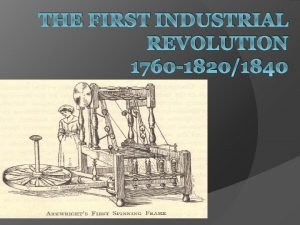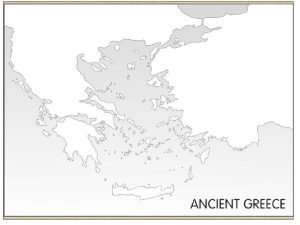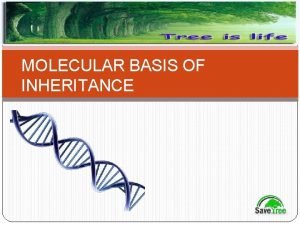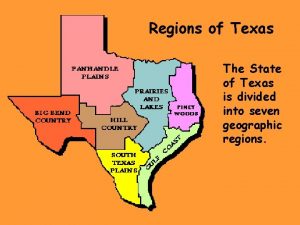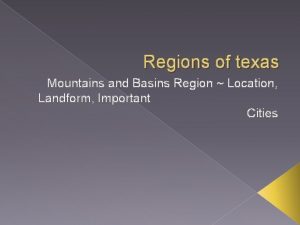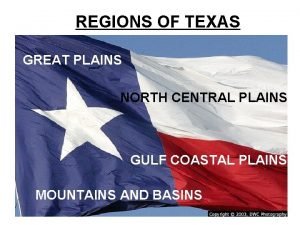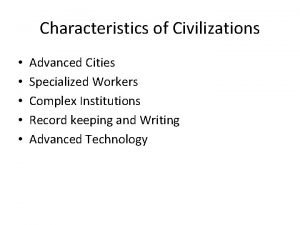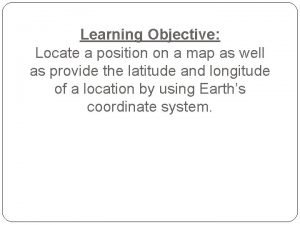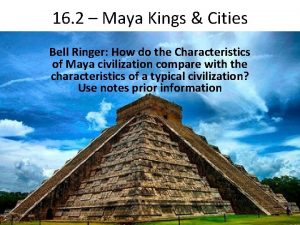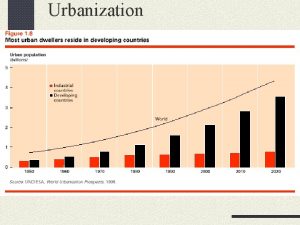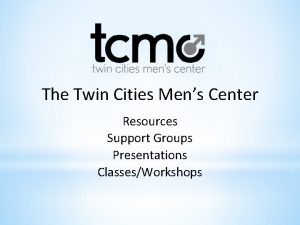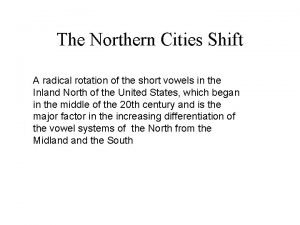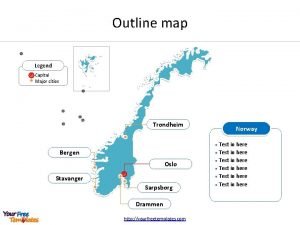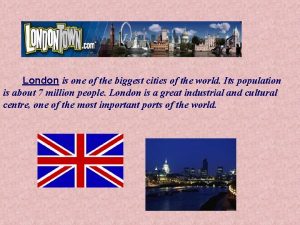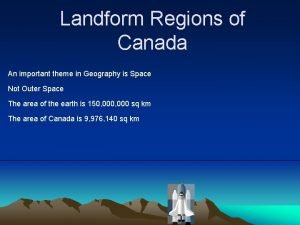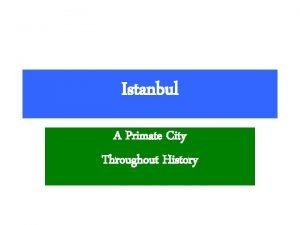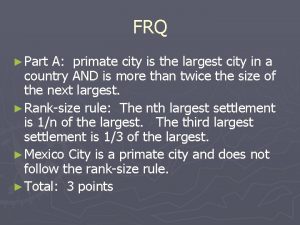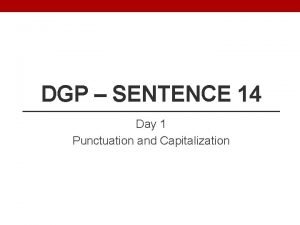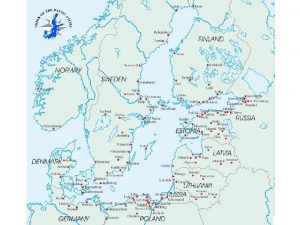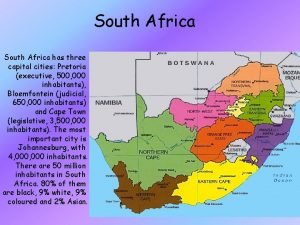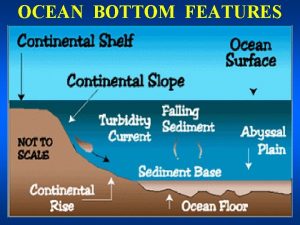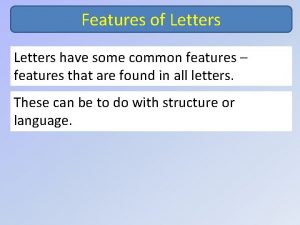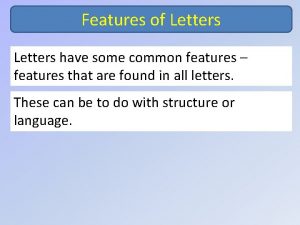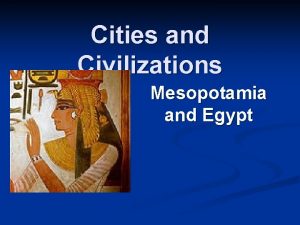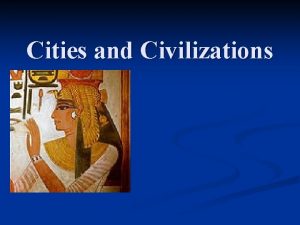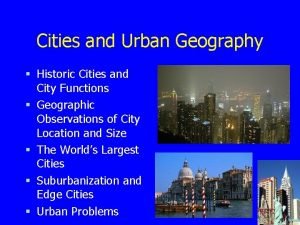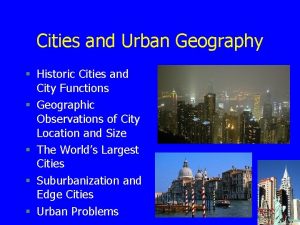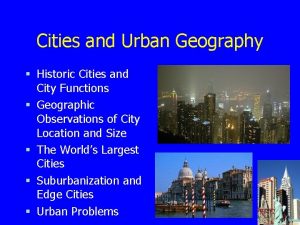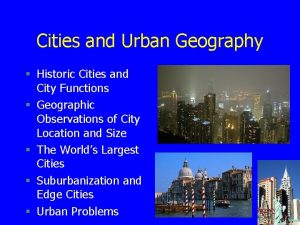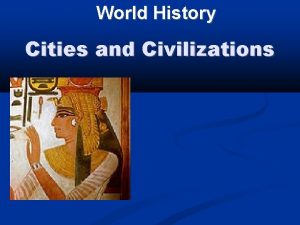States and Cities General features of early states























































- Slides: 55

States and Cities General features of early states: • urban (organized into full-blown, formal cities and rural hinterlands) • well defined and often large territories (not one or a few settlements) • economies based on centralized accumulation of capital through taxation and tribute • stratified, with social status largely determined by birth into one or another well defined social class (some social mobility); e. g. , ruling elite, bureaucratic and religious officials, warrior, craft specialist, commoner, slave classes • legitimate use of coercive force (law) and standing armies • certain features, such as monumental architecture and public buildings, writing, sophisticated mathematics, engineering, and calendars, state religion and arts, etc.

The Urban Revolution (see pp. 196 -197) • V. Gordon Childe defined urban societies as a revolution based on the presence of certain key elements, most notably: cities, writing, surplus, metallurgy, craft specialization, and social classes • he felt that technological innovations (e. g. , metallurgy, writing), craft specialization, and agricultural surplus were key in the emergence of ancient states • as in his reconstruction of a “Neolithic Revolution” he felt that states were an advancement over earlier cultural forms and given the right conditions a natural development for humankind

The Hydraulic (Irrigation) Hypothesis (pp. 196 -197) • In 1950 s, Karl Wittfogel (Oriental Despotism) suggested a model for the emergence of the major Asian civilizations (China, India, Mesopotamia, and also Egypt and others) • mechanisms of large-scale irrigation closely linked to emergence of state, including greater planning and coordination (water scheduling, calendars, construction planning, labor control), which required strong leadership and administration • irrigation provided more stable productivity and increased wealth, and also required defense • this resulted in increasing differentiation and social inequality (between leaders, administrators, and other high-ranking individuals and commoners), ultimately leading to despotic power by rulers

Wittfogel’s Hydraulic Hypothesis

Warfare and State Formation (pp. 196 -197) • Carneiro’s (1970) circumscription theory: – In areas of circumscribed agricultural land, population growth leads to competition and conflict; – this in turn leads to warfare; – victorious villages subjugate others and develop regional pyramidal (rank-order) hierarchy

Carneiro’s (1970) Circumscription Theory

• Trade and cultural interaction between societies also a critical element of the rise and spread of states, including secondary state formation • Current perspectives emphasize variation of state and urban forms and multi-causal factors in state/urban formation, rather than single primary causes (“primemovers”) or pathways to social complexity)


Upper Mesopotamia Lower Mesopotamia

Mesopotamia: “The Cradle of Civilization” • Mesopotamia, meaning “Land between the Rivers” in Greek, refers to an area (roughly 600 by 150 miles) from the meeting of the Tigris and Euphrates Rivers, in Iraq • First clear states in the world with the emergence of powerful citystates like Uruk, Ur, Eridu and others in the Late Chalcolithic (4200 -3000 BC), which followed the small farming villages and towns (chiefdoms) of the region, associated with the preceding Early Chalcolithic “Ubaid” period (5900 -4200 BC) • By 3200 BC first “true” urban centers in lower Mesopotamia • Bronze Age (3000 -1200 BC) Mesopotamia included Sumer civilization and the Akkadian, Babylonian and Assyrian empires.

alluvium

Ubaid Period (5900 -4200 BC) • Early Chalcolithic; beginning in Lower Mesopotamia, first identified at site of Tellal-Ubaid in southern Iraq, the Ubaid culture became widely spread throughout Lower and Upper Mesopotamia and adjacent areas, by 5, 000 BC • Early evidence of ranked (complex) societies and earliest evidence of irrigation

Ubaid: the Roots of Mesopotamian Civilization • Ubaid (5900 -4200 BC) were generally small farming villages and towns linked to shared ceremonial centers through kin relations • Clear evidence of social ranking as some ceremonial centers grew in importance, such as Eridu, with significant differences in amount of wealth in burials and small monuments • Craftworkers and artisans lived a short-distance from elite temples, and food-producers lived farther away • By late Ubaid, Eridu was urban-scale settlement characterized by large temples (ziggurats) and administrative precincts

Eridu, southern Iraq • Sequence of temples dedicated to Enki, the water god, were identified at Eridu that spanned much of the Ubaid and later Uruk period (5, 000 to 3, 000 BC) • Shows continuity of religious cult in a specific location • Temples were highly significant elements in the origins of complex societies in the region, their priests and administrators oversaw many aspects of daily life, including land labor management, distribution of food, and, above all, the correct procedures for religious rites and rituals • Large temples or “ziggurats” were a critical feature of Mesopotamian civilization throughout its long history

Sequence of superimposed temples found at Eridu

TEPE GAWRA (NE IRAQ), Late Ubaid (after 5200 BC) Clay cylinder seals found associated with temples (early pictographic writing) Tell-al-Ubaid, Uruk, Eridu

Uruk Period (4200 -3000 BC) • Late Chalcolithic; Uruk also widely spread throughout Mesopotamia and adjacent areas • Earliest fully urban societies (city-states), by 3200 BC in lower Mesopotamia • Specialized production and administration, and early pictographic writing and protocuneiform (“wedge-shaped”) script by 3000 BC

Uruk: “first genuine city on the world”

Inanna Eanna precinct, late Uruk IV (ca. 3200 -3000 BC)

Uruk IV, 3100 BC


Sumerian City-States, 3000 -2000 BC “Sumeria”


UR Multiroomed structure


Reconstruction of Royal Tomb at Ur

Monuments of Power • Elite were exalted as semidivine in life, and in death received special treatment, both in burial and in the afterworld • monuments, “templetowers” called ziggurats, originally oriented toward community-based rituals, where increasingly controlled by elite rulers and other high-class individuals (priests and bureaucrats)

Ur-Nammu Ziggurat


Writing cuneiform • By c. 3400 BC the first evidence of writing appears (pictographs) • sophisticated abstract iconographic writing in ancient Sumerian Civilization called cuneiform (“wedge”), developed by ca. 2500 BC • complex commercial transactions (accounting) are one theory for the increasing development of Sumerian writing


Uruk IV tablet, ca. 3100 -3000 BC (Pictographic signs)

Ebla archive, 2400 -2350 BC (Sargon of Akkad) 2100 clay tablets from Palace G

What Were They Writing About Early Mesopotamian Tokens • In many places, writing came about as a means to record the great people and events: heroic history • In Mesopotamia, much early writing reflected economic concerns: property ownership and accounting • Measurement and cultivation of fields of officials, quotas of grain to laborers, counting flocks

Writing Systems of the Ancient World


Kings and Classes • Writing also spoke of the ascensions and actions of kings • ultimately Sumerian rulers became more despotic forcibly controlling their subjects and engaging in costly wars between kingdoms • kings and other elites had a privileged relation to and control over divine forces

“War” side Standard of Ur, Early Dynastic Period (2500 BC)

“Peace” side Standard of Ur, Early Dynastic Period (2500 BC)

Stone stela of Naram-Sin, c. 2250 BC, showing his victory over mountain tribes

Stela of Hammurabi, c. 1770 BC, describes gods and cities that supported him, his divinely sanctioned rule, social classes, and his public works

Nippur Map, 1300 BC


Akkadian empire • Final three centuries of 3 rd millennium BC saw the rise of political entities interpreted as empires – large-scale political entities (composed of numerous states) with a core area and vast areas subject to core • Akkadian empire was the first of these, initiated by Sargon the Great (2334 -2279 BC) from his capital near Babylon • Akkadian also refers to Semitic language (Afro. Asiatic family)

Sargon the Great ruled Sumer from about 2334 -2279 B. C.

Ishtar Gate Babylon, Sacked by Hittites in 1595 BC


Mari, Upper Mesopotamia (ca. 1750 BC))

Uluburun shipwreck, sank in 14 th century BC carrying copper ingots from Cyprus, cobalt-blue and turquoise glass among many other trade goods

Uluburun Phoenicians (1200 -600 BC) from central Levant emphasized commerce, and developed first alphabetic writing systems by 1000 BC

Isrealites (11 -8 th Century BC) • Early Iron Age saw the rise of the kingdoms of Israel and Judah in highlands of southern Levant, entities that can be characterized as nation-states, a stage beyond the existence of contemporary city -states sharing a common material culture

Assyrian Empire (collapsed 612 BC)

The Applied History Research Group (2000)

The Applied History Research Group (2000)

The Applied History Research Group (2000)
 Early cpr and early defibrillation can: *
Early cpr and early defibrillation can: * What early industries mechanized the united states?
What early industries mechanized the united states? Ancient greece map with labels
Ancient greece map with labels Trna the adapter molecule
Trna the adapter molecule Chapter 32 an overview of animal diversity
Chapter 32 an overview of animal diversity United states physical geography
United states physical geography Diferencia entre gran plano general y plano general
Diferencia entre gran plano general y plano general Where did general lee surrender to general grant?
Where did general lee surrender to general grant? What were the 11 free states
What were the 11 free states Southern states vs northern states
Southern states vs northern states Big states vs small states guard against tyranny
Big states vs small states guard against tyranny Primate city definition geography
Primate city definition geography Mee kam ng
Mee kam ng Smart cities presentation
Smart cities presentation What region is texas in
What region is texas in Cities in the mountains and basins region of texas
Cities in the mountains and basins region of texas North central plains weather
North central plains weather Sustainable cities and society
Sustainable cities and society Advanced cities and specialized workers
Advanced cities and specialized workers Lesson 5 a nation of cities
Lesson 5 a nation of cities Hpact
Hpact Usa map latitude longitude
Usa map latitude longitude Work life and leisure cities in the contemporary world
Work life and leisure cities in the contemporary world Maya kings and cities
Maya kings and cities Alpha beta gamma cities ap human geography
Alpha beta gamma cities ap human geography Primate cities
Primate cities Why do cities exist
Why do cities exist Sprawl ap human geography
Sprawl ap human geography Men's center
Men's center Northern cities shift
Northern cities shift The gray-brown haze often found over large cities is called
The gray-brown haze often found over large cities is called How many capital cities in south africa
How many capital cities in south africa 7 mountains of jerusalem
7 mountains of jerusalem Rank-size rule
Rank-size rule Map of norway cities
Map of norway cities Major cities in scotland map
Major cities in scotland map Cities in asl
Cities in asl London is one of the largest cities in the world positive
London is one of the largest cities in the world positive A tale of two cities literary devices
A tale of two cities literary devices How were the appalachians formed
How were the appalachians formed Wat is een primate city
Wat is een primate city Positive effects of primate cities
Positive effects of primate cities Fox cities exhibition center
Fox cities exhibition center In the novel a tale of two cities dgp
In the novel a tale of two cities dgp Detroit sister city
Detroit sister city What luxuries did cities offer to the middle class
What luxuries did cities offer to the middle class Mdc and ldc
Mdc and ldc Golden thread a tale of two cities
Golden thread a tale of two cities Most dangerous cities in the world
Most dangerous cities in the world Urbanisation in contrasting global cities
Urbanisation in contrasting global cities Padi transgenik
Padi transgenik Cities in wales
Cities in wales How do you keep your city clean short answer
How do you keep your city clean short answer Union of baltic cities
Union of baltic cities Three capital cities of south africa
Three capital cities of south africa Solar cities biogas
Solar cities biogas

